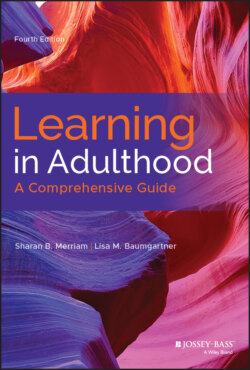Читать книгу Learning in Adulthood - Sharan B. Merriam - Страница 32
Chapter 3 Learning Environments and Learning Concepts
ОглавлениеIf asked about their learning, adults first picture classrooms with “students” and “teachers” and will often respond that they haven't taken any classes lately. We've been conditioned to think of learning as courses or workshops sponsored by the workplace, colleges and universities, public schools, and other formal organizations. Yet most learning in adulthood is much more informal. When we ask these same adults about what they have learned over the last year related to their hobbies, communities, family activities, or health, they typically respond with descriptions of learning activities outside of formal settings. They discuss, for example, remodeling a kitchen, which has involved everything from reading and talking with friends to conversations with carpenters, plumbers, and electricians. Or they may focus on an important change in their life, such as an illness, parenthood, or job change, which has precipitated numerous learning events, sometimes over an extended period of time. In considering the spectrum of learning opportunities available to adults, it is important to acknowledge all of these arenas of learning, from the highly structured to the more informal ways adults go about learning.
Why is it important that educators of adults recognize that learning happens in so many and varied places in the lives of adults? First, appreciating and taking into consideration the prior knowledge and experience of learners has become a basic assumption of our practice as educators of adults, wherever this knowledge was learned. In working with low-income mothers, for example, instructors might recognize that these parents have had to learn how to take care of their children on very constrained budgets, keep their families safe and healthy under difficult living conditions, and in general make do with very little. Rather than asking questions about how they have learned to do this successfully, the focus is often on their lack of formal education and skills training. Formal schooling and skills training are important, but so are the ways they have informally learned about life skills that have kept them and their families fed and clothed. Likewise, workshop leaders designing staff development programs for teachers might first learn as much as possible about the background and experience of the teachers in that school and what their knowledge base is with respect to the content of the workshop. There is nothing that alienates teachers more in these programs than being treated as if they know very little about the subject matter, especially if they have been dealing with it on a daily basis.
Second, if educators helped learners recognize the many places and ways they have gone about learning in adulthood, more adults might see themselves as active learners. As a result, they might be less cautious about learning new things and even be more willing to enter formal programs of learning. One of our favorite stories is about a duck carver who was interviewed as part of a study on self-directed learning (Berger, 1990). This man, who considered himself both a nonreader and “definitely not a very good student,” taught himself how to carve ducks. He started this process by carving some ducks by himself and then taking them to duck carving shows, where he could talk with other artists about his initial attempts. In addition, he read every book he could get his hands on related to duck carving (and remember, he thought of himself as a nonreader). He now raises ducks so he can have live models, in itself another learning project. As a result of the interview process, this man saw himself as much more of a learner than he had before. Our hope is that as more individuals view themselves as active and competent learners, at least in some areas, they might be better able to address the many life challenges that come in adulthood, through both formal and informal learning modes.
In exploring the spectrum of learning opportunities in adulthood, we first discuss each of the primary arenas in which adult learning occurs: those sponsored by formal institutions, nonformal community-based learning activities, and learning that is more informal or self-directed in nature. We then explore online learning as a fourth site for learning, one that overlays formal, nonformal, and informal modes of learning. Although there are other terms in use, we have chosen to use the term online learning because it is the most common term used to refer to learning through the use of computers anchored to communication networks. A second section of the chapter presents two related concepts—organizational learning and the learning organization. Finally, we end the chapter with a discussion of lifelong learning and the learning society.
